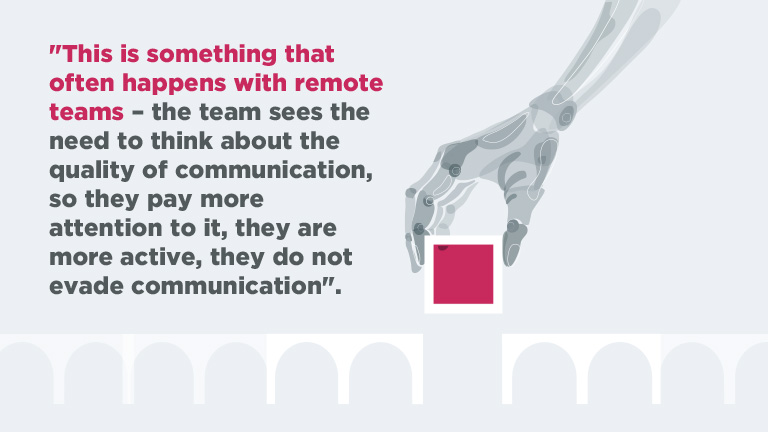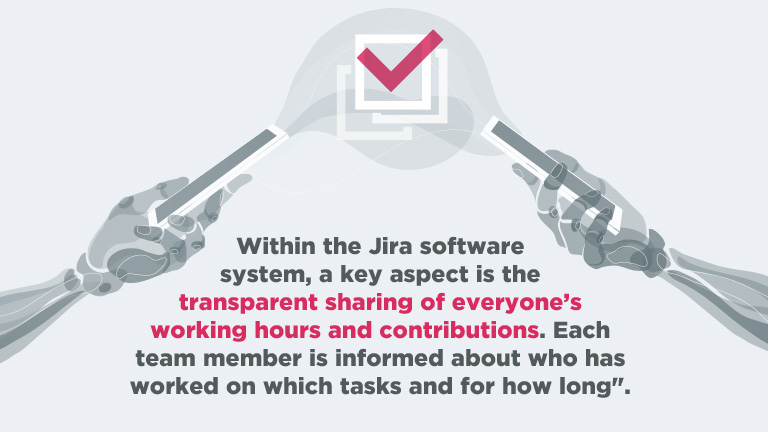Managing dispersed teams in medical software projects
The development of modern technologies, also from medical software projects area, globalisation and increasing difficulties in finding the right “local” employees to join the ranks of more and more companies make the number of projects carried out by the so-called dispersed teams, remote teams or hybrid teams grow every year. I asked Aleksandra Harnasz, a leader who knows the in(s) and out(s) of managing such teams, to share her experience.
To quote Lamson Consulting: According to a recent study published by Upwork.com; globalization, skill specialization, and agile team models will change the workforce in the next ten years. The second annual Future Workforce Report [1] found that 63 percent of companies have remote workers but more than half – 57 percent – lack the policies to support them.
What kind of problems do you face as a dispersed team leader and how do you deal with them?
Aleksandra Harnasz: I would refer to quite basic issues or policies. They are the ones that most determine the quality of work perceived. First of all, managing such a team is certainly a communication challenge. How to communicate, how it’s supposed to be organised.
Every day we have stand-ups, during which we update one another on what has been completed, and what hasn’t. Moreover, we talk about challenges – who is stuck and where who has problems and of what kind. We see the client for whom we are running the project every 2 weeks. The whole team then presents what they have done and what they haven’t done together. We plan the work for the next 14 days. This is a lot – to hear each other every day. Frequent communication can eliminate the discomfort of physical distraction. I would say that if properly planned, it can even eliminate the “distance factor”.
Everyday communication in medical software projects
In the above-mentioned day-to-day communication, we use standard solutions. We use Skype, Microsoft Teams, Slack or mobile phones to make the call. It is important to ensure good quality of the call. There is nothing more frustrating than crackling noises, and not being able to hear. These small details are worth taking care of because thanks to a good quality of connection you can achieve the effect of closeness. We can lead to a situation where you no longer feel any difference whether this someone is standing next to you or talking from another part of the globe.
I also make sure that these virtual meetings we have together are untouchable and non-transferable. Always on the same days, at fixed times. They should be arranged in a clear and permanent scheme. The quality of the connection should be taken care of, conference rooms should be reserved, a tool available for everyone should be chosen. Everyone must know how to join the teleconference. For me it has always built up a regularity, a sense of stability. This work then becomes equally organized for everyone.
In your opinion, using technology can ensure effective communication and help you avoid problems with it?
AH: It’s not just about technology. What I find interesting in the context of dispersed teams is a sort of contact deficit. Each side is trying to reduce that deficit. I would actually say that you can even expect the remote team to take much more care and contact. Moreover, make better use of the limited time we spend together. This is something that often happens with remote teams. The team sees the need to think about the quality of communication, so they pay more attention to it. They are more active, they do not evade communication.

As far as polices are concerned, what else should be standardized at the launch of a dispersed team?
AH: Surely the important thing is a clear and transparent system of reporting work. Members of dispersed teams often have such a fear that if other team members are on the other end of skype, then maybe they are just lying there and watching Netflix. It’s something that comes to everyone’s mind that if the boss doesn’t see the work with his/her own eyes he/she doesn’t know if they are actually working. Here, one of the tools that always works well for me is a clear, transparent system, available to every team member in every location. At GLI we use Jira software daily. It serves as a versatile platform for effective project management. Moreover, managing tasks, tracking bugs, and monitoring issues.
How do you deal with a situation where someone hasn’t reported tasks in Jira?
AH: I kindly remind those who are yet done their tasks to catch up. Within the Jira software system, a key aspect is the transparent sharing of everyone’s working hours and contributions. Each team member is informed about who has worked on which tasks and for how long. This information is readily available to all, fostering a common understanding. As time progresses and team members become more accustomed to one another, a natural routine forms, with individuals confidently taking on specific responsibilities.
However, there is an important matter that warrants in-depth consideration. Throughout my experience, I’ve encountered teams with whom I’ve never had the chance to meet face-to-face. In such scenarios, establishing a strong connection on a human level becomes crucial, particularly in a leadership role. In a distributed team, there are instances, especially among those who are more reserved, where assurances are given that everything is proceeding smoothly. Despite being able to monitor factors like leave, illness frequency, overall progress, and productivity, the absence of physical interaction means that I lack insight into various non-verbal cues. These cues, such as a person’s demeanor, morning routine, or expressions, provide valuable information about their well-being and concerns. Unfortunately, as a leader in this context, I am deprived of these non-verbal signals, which can be a significant source of knowledge.

Do you have any tactics to take care of this area, to elicit such knowledge?
AH: I always say that unfortunately not everyone is cut out to be a remote employee. In the process of recruiting members of such a team, special attention should be focused on people with high interpersonal skills, who are aware of the need to be open and willing to talk about problems. Otherwise if you don’t say something, it won’t exist and in spite of his/her sincere intention, a leader without proactivity on the part of the employee has no chance to take care of this human side, then depersonalization of the relationship will occur. This is a gap resulting from the fact that we do not see each other every day and this risk should be born in mind.
How to build trust in a dispersed software team?
AH: Trust is the spice of remote teams! In Poland, we have a proverb which says that trust must be earned, although my experience puts its legitimacy a little bit in doubt ????.
In a dispersed team, you can’t see what the other person is doing. You can only account for the results of your work, as you know dispersed teams are task teams: you work on a specific task, with a registered execution time.
On the other hand, I have observed an amazing thing: very often the mere fact that we start to work remotely and account for the effects of our work puts unspoken pressure on us to trust each other. The lack of physical contact creates a void that demands to be filled.
Reporting of work in dispersed teams
Thoughts keep racing in your head: “If nobody is looking at me, how can I justify my hours of work? I have to prove my occupancy and my efficiency. There is a greater desire to give the other person the feeling that I can be relied upon. Here, you have to strive for this trust much more. You have to put out a little bit more so that someone can see it, and hear it. You have to make your own proactive contribution so that you will be seen. And since everyone makes this effort to satisfy also their own psychological needs, trust becomes a default element in dispersed teams.
When we start working on a remote project, the mechanism of social contract known from management psychology is activated. The lack of direct contact makes these people want to be more trustworthy. It becomes one of the important individual goals. I have not observed this phenomenon on such a scale in projects where all employees work in one location. We do much more because of the discomfort caused by not seeing each other.

Finally, the question is: does working in a dispersed team offer any added value?
AH: Working in a distributed team develops and builds new competences in people. It improves communication skills. People stop being blocked or feeling the stress of participating in calls or teleconferences.
References:
[1] Future Workforce Report https://www.leadwithdei.com/
Contact us if you have any questions!